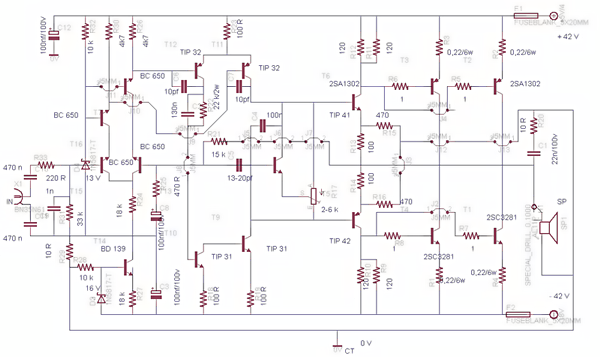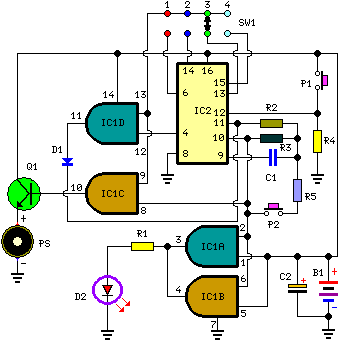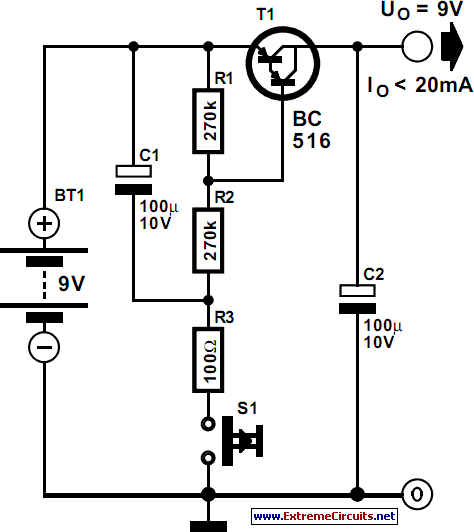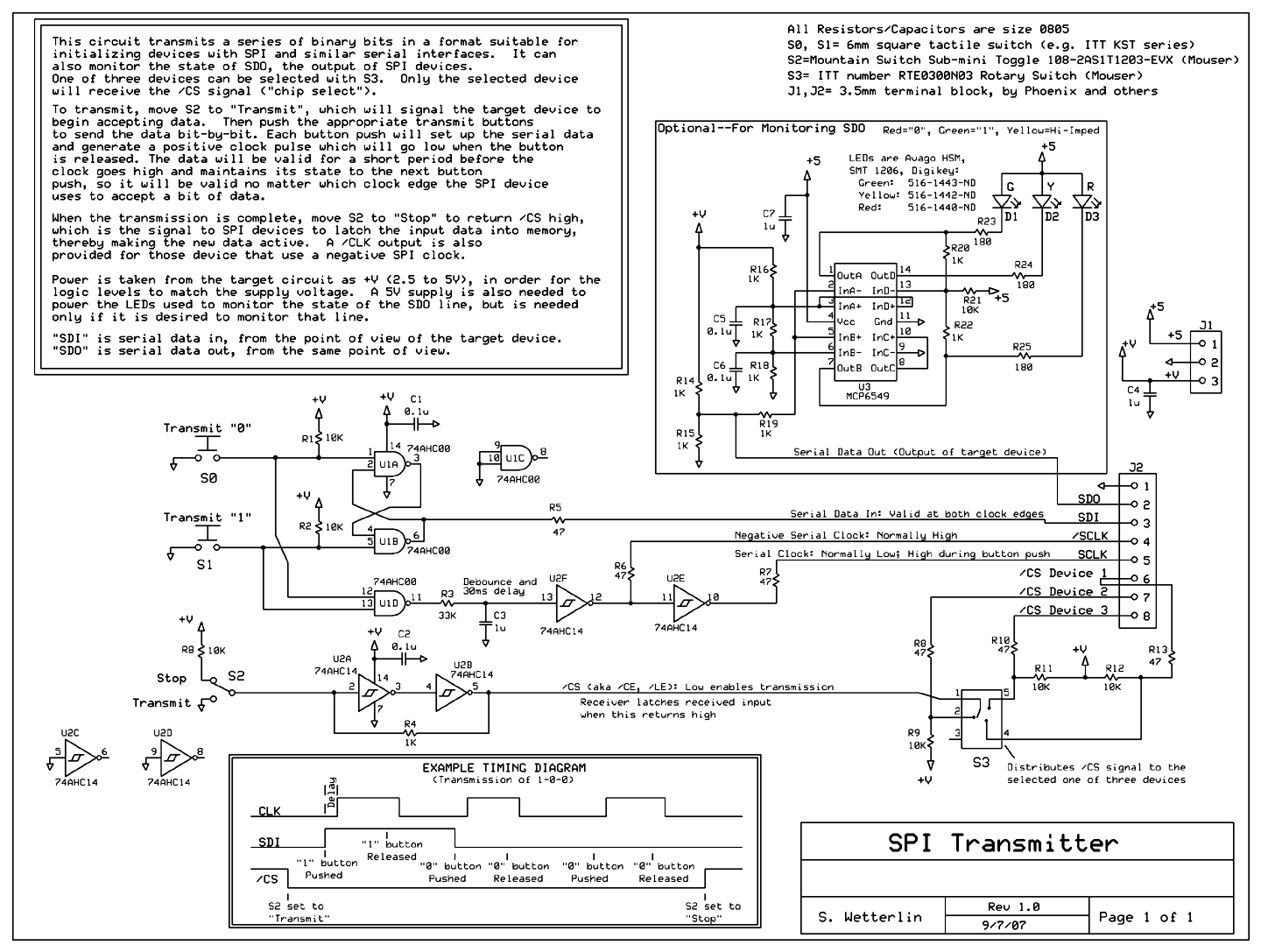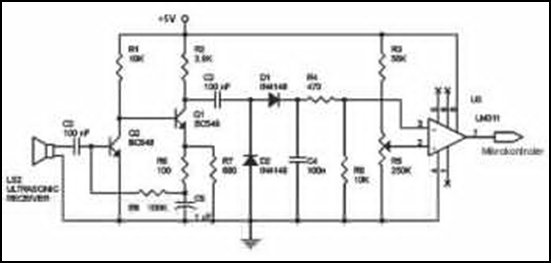
lm324 wave generator vco schematic
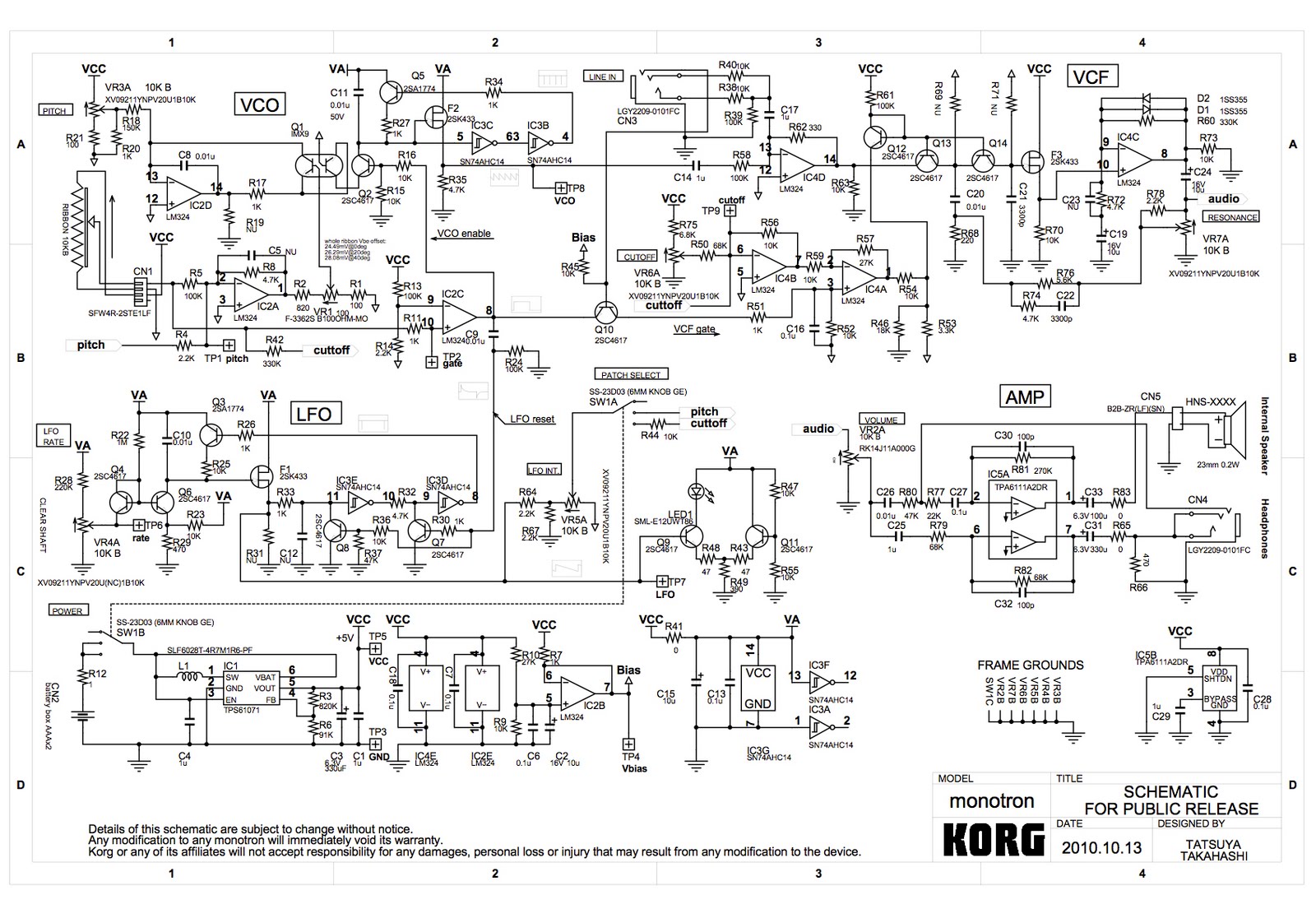
A voltage-controlled oscillator (VCO) using the LM324 operational amplifier is being developed, inspired by the Korg Monotron schematic. The goal is to create a simple circuit that produces audible waveforms, specifically square and triangle waves, when connected to a speaker. The LM324 alone is not sufficient to function as a VCO; a JFET needs to be incorporated. Additionally, the LM324 cannot drive a speaker directly, necessitating the use of an audio power amplifier, such as the LM386. Modifications to the circuit can be made by adjusting the values of capacitor C1 or resistor R4 to change the frequency of the output waveforms. The circuit should be AC-coupled to the audio amplifier using a large capacitor. While the LM324 can generate square and triangle waves, it is not classified as an oscillator without additional components. There is a mention of using a CD40106 IC, which can create multiple square-wave oscillators with minimal components. The LM386, while capable of driving a speaker, has a low output power of 0.45W at clipping into an 8-ohm load with a 9V supply. The individual is currently experimenting with breadboarding and is seeking guidance on how to transition from a waveform generator to a proper oscillator.
A voltage-controlled oscillator (VCO) can be constructed using the LM324 operational amplifier, commonly found in synthesizer applications like the Korg Monotron. To achieve the desired audible waveforms, the circuit must incorporate a JFET to enable the LM324 to function effectively as a VCO. The basic configuration involves using the op-amp in a feedback loop that allows for the generation of square and triangle waves.
The output frequency of the VCO can be adjusted by varying the capacitance of C1 or the resistance of R4. These components determine the charge and discharge rates of the timing capacitor, thereby controlling the frequency of the generated waveforms. It is essential to couple the output of the LM324 to an audio power amplifier, such as the LM386, through an AC coupling capacitor to ensure that the audio signal is appropriately amplified for driving a speaker.
The LM386 is a low-power audio amplifier capable of delivering 0.45W into an 8-ohm load when supplied with 9V. This makes it suitable for small speaker applications, but its power output is limited. If a higher output is required, alternative power amplifiers may be considered.
While the LM324 can generate square and triangle waves, it does not inherently qualify as an oscillator without additional components. The distinction between a waveform generator and an oscillator lies in the ability of the circuit to produce a continuous oscillating signal without external triggering. The addition of a JFET or other components can facilitate this transition, allowing the circuit to operate as a true oscillator.
For those seeking alternatives, the CD40106 IC offers a different approach, enabling the creation of multiple square-wave oscillators with minimal passive components. Each oscillator can be configured with just one resistor and one capacitor, providing a straightforward method for generating square waves.
In summary, constructing a VCO with the LM324 requires careful consideration of component selection and configuration. The integration of a JFET, proper frequency adjustment through capacitors and resistors, and the use of an audio amplifier are critical steps in achieving the desired functionality.A vco using the LM324. I have the schematic to the korg monotron, which uses the lm324 as the IC for the vco, but I am struggling to create a simple circuit in which the lm324 will produce an audible wave form when connected to a speaker. can anyone help from what i have gathered this should produce a square wave correct An LM324, by itself, is not a VCO; you have to add the JFet to
make a VCO. An LM324, by itself, cannot drive a speaker; you will need an audio power amplifier, like an LM386 to do that. I`m not sure if this is what you want, but it will produce a square wave and triangle wave. Change the frequency by changing C1 or R4. AC couple it with a large capacitor to your audio amplifier. An LM324, by itself, is not a VCO; you have to add the JFet to make a VCO. An LM324, by itself, cannot drive a speaker; you will need an audio power amplifier, like an LM386 to do that.
Its what is used in that little Korg Monotron synthesizer, which is why i purchased the chips. I am trying to figure out how to create an oscillator with it without using a 386 audio amp if thats possible I know it can be done with a 40106 but can it be done with the LM324 audioguru thanks for that link. A CD40106 IC can make six square-wave oscillators with just one resistor and one capacitor for each oscillator.
An opamp can make the same oscillator but with an added resistor. If you want to drive a speaker then you need a power amplifier. An LM386 has a low output power of only 0. 45W at clipping into 8 ohms when it has a 9V supply. im breadboarding this right now, thank you everyone for your help, im teaching myself about circuit building and am a noob, thanks for answering my stupid questions. Although I can generate a square wave with the lm324 and with a bit of luck a triangle wave as well, and adjust the rate in which the capacitor charges and discharges using a potentiomiter, this still isnt an oscillator is it How do i bridge the gap between a waveform generator and an oscillator Although I can generate a square wave with the lm324 and with a bit of luck a triangle wave as well, and adjust the rate in which the capacitor charges and discharges using a potentiomiter, this still isnt an oscillator is it How do i bridge the gap between a waveform generator and an oscillator
🔗 External reference
A voltage-controlled oscillator (VCO) can be constructed using the LM324 operational amplifier, commonly found in synthesizer applications like the Korg Monotron. To achieve the desired audible waveforms, the circuit must incorporate a JFET to enable the LM324 to function effectively as a VCO. The basic configuration involves using the op-amp in a feedback loop that allows for the generation of square and triangle waves.
The output frequency of the VCO can be adjusted by varying the capacitance of C1 or the resistance of R4. These components determine the charge and discharge rates of the timing capacitor, thereby controlling the frequency of the generated waveforms. It is essential to couple the output of the LM324 to an audio power amplifier, such as the LM386, through an AC coupling capacitor to ensure that the audio signal is appropriately amplified for driving a speaker.
The LM386 is a low-power audio amplifier capable of delivering 0.45W into an 8-ohm load when supplied with 9V. This makes it suitable for small speaker applications, but its power output is limited. If a higher output is required, alternative power amplifiers may be considered.
While the LM324 can generate square and triangle waves, it does not inherently qualify as an oscillator without additional components. The distinction between a waveform generator and an oscillator lies in the ability of the circuit to produce a continuous oscillating signal without external triggering. The addition of a JFET or other components can facilitate this transition, allowing the circuit to operate as a true oscillator.
For those seeking alternatives, the CD40106 IC offers a different approach, enabling the creation of multiple square-wave oscillators with minimal passive components. Each oscillator can be configured with just one resistor and one capacitor, providing a straightforward method for generating square waves.
In summary, constructing a VCO with the LM324 requires careful consideration of component selection and configuration. The integration of a JFET, proper frequency adjustment through capacitors and resistors, and the use of an audio amplifier are critical steps in achieving the desired functionality.A vco using the LM324. I have the schematic to the korg monotron, which uses the lm324 as the IC for the vco, but I am struggling to create a simple circuit in which the lm324 will produce an audible wave form when connected to a speaker. can anyone help from what i have gathered this should produce a square wave correct An LM324, by itself, is not a VCO; you have to add the JFet to
make a VCO. An LM324, by itself, cannot drive a speaker; you will need an audio power amplifier, like an LM386 to do that. I`m not sure if this is what you want, but it will produce a square wave and triangle wave. Change the frequency by changing C1 or R4. AC couple it with a large capacitor to your audio amplifier. An LM324, by itself, is not a VCO; you have to add the JFet to make a VCO. An LM324, by itself, cannot drive a speaker; you will need an audio power amplifier, like an LM386 to do that.
Its what is used in that little Korg Monotron synthesizer, which is why i purchased the chips. I am trying to figure out how to create an oscillator with it without using a 386 audio amp if thats possible I know it can be done with a 40106 but can it be done with the LM324 audioguru thanks for that link. A CD40106 IC can make six square-wave oscillators with just one resistor and one capacitor for each oscillator.
An opamp can make the same oscillator but with an added resistor. If you want to drive a speaker then you need a power amplifier. An LM386 has a low output power of only 0. 45W at clipping into 8 ohms when it has a 9V supply. im breadboarding this right now, thank you everyone for your help, im teaching myself about circuit building and am a noob, thanks for answering my stupid questions. Although I can generate a square wave with the lm324 and with a bit of luck a triangle wave as well, and adjust the rate in which the capacitor charges and discharges using a potentiomiter, this still isnt an oscillator is it How do i bridge the gap between a waveform generator and an oscillator Although I can generate a square wave with the lm324 and with a bit of luck a triangle wave as well, and adjust the rate in which the capacitor charges and discharges using a potentiomiter, this still isnt an oscillator is it How do i bridge the gap between a waveform generator and an oscillator
🔗 External reference
